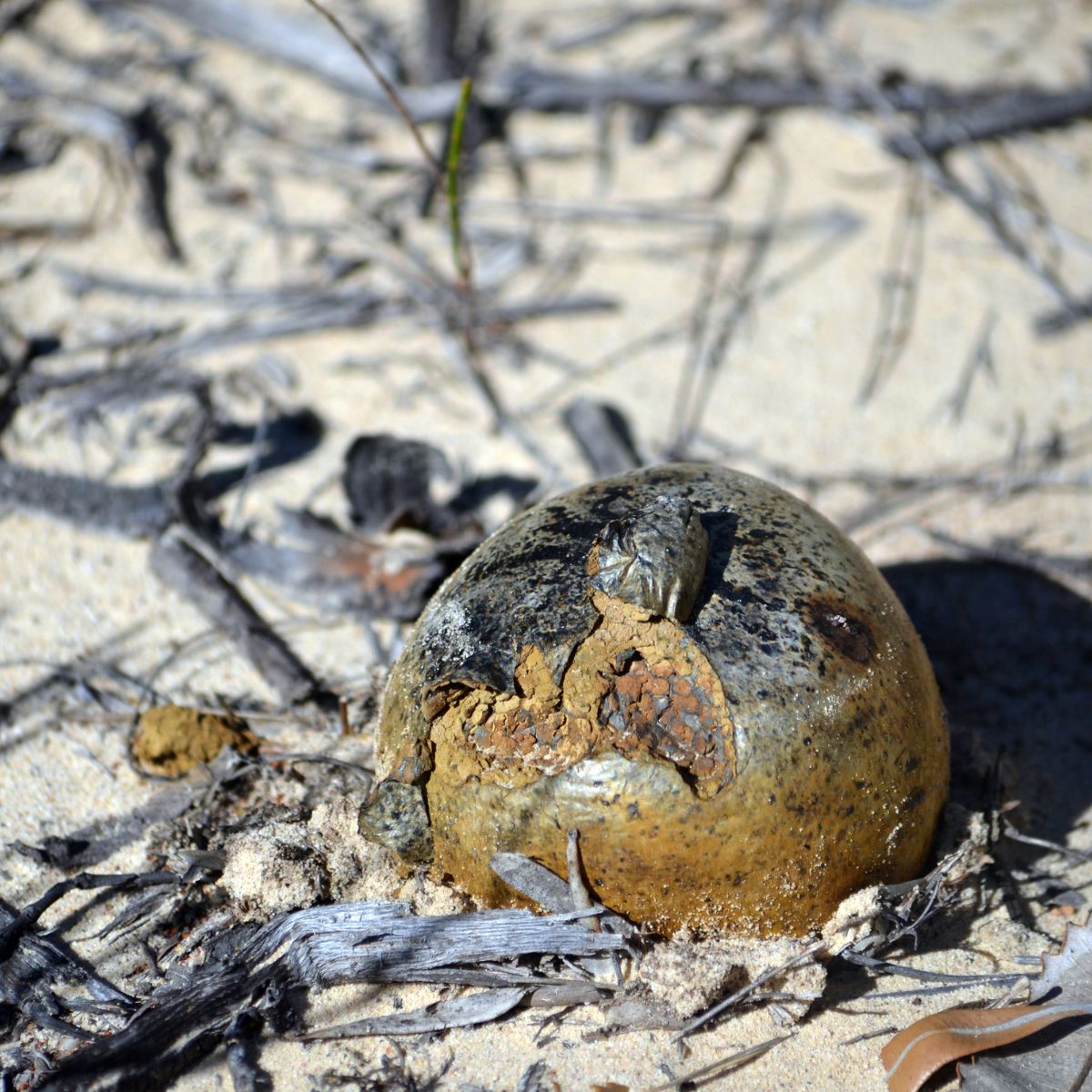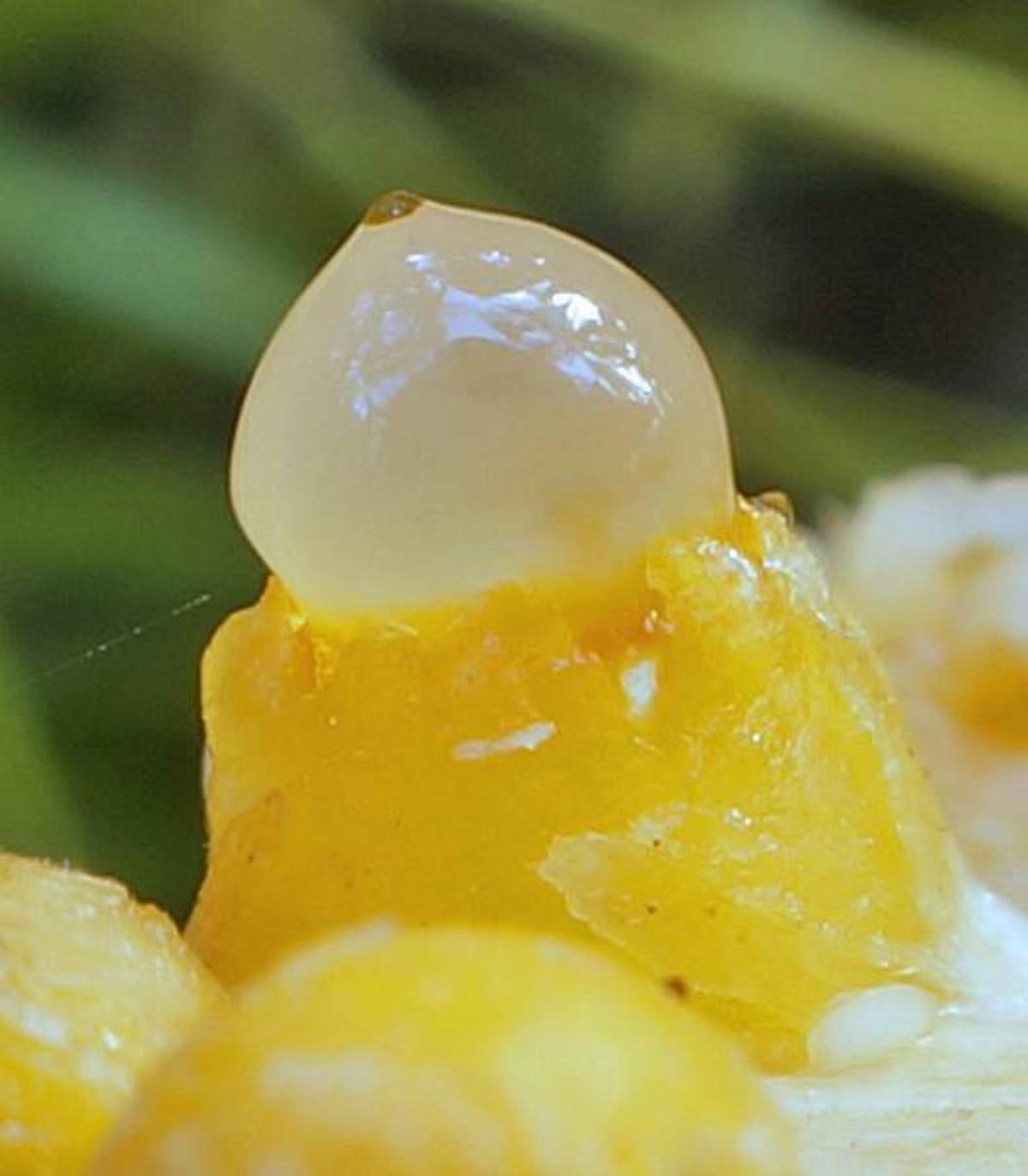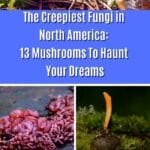Prepare yourself for a spine-chilling journey as we explore the creepiest fungi that inhabit the forests of North America. These bizarre organisms will leave you in awe and maybe even haunt your dreams! From devilish fingers to blood-like oozing mushrooms, nature has truly outdone itself in creating these peculiar and eerie creations. Who needs science fiction when you have Mother Nature?
Jump to:
- 1. Beefsteak Mushroom: A Horror Movie IRL
- 2. Devil’s Fingers, aka Octopus Stinkhorn: When Horror Takes Shape
- 3. Devil’s Tooth: A Fungal Bloodbath
- 4. Dead Man’s Fingers: Nature’s Grisly Reminder
- 5. Dead Man’s Foot: Nature’s Grisly Slapstick, or The Ugliest Fungus In The World (TUFITW)
- 6. Common Stinkhorn: A Shameless Display
- 7. Shooting Star: The Witch’s Popped Wart
- 8. Cordyceps: The Deadly Invader
- 9. Witches’ Butter: Mysterious, Spellbinding, and Icky
- 10. Wood Ears: A Severed Body Part Party
- 11. Purple Jellydisc: The Alien Brains
- 12. Nose of Dog: The Perfect Ingredient For Witches Brew
- 13. Ink Cap: The Mysterious Melting Mushroom
1. Beefsteak Mushroom: A Horror Movie IRL

The Beefsteak mushroom (Fistulina hepatica) legitimately looks like a slab of meat on a tree. Like, maybe someone went around stapling bloody organs to trees for the fun of it. It isn’t just the outer appearance that is meat-like, either.
When you cut the beefsteak open, it is nicely marbled and bleeds a dull red juice all over the cutting board. And if you think you’re getting away with slicing this mushroom without any consequences, think again. The red juice stains everything; you can’t wash this away, Lady Macbeth.
Beefsteak mushrooms are edible and considered a delicacy. They don’t taste like beef; they actually have a sour to rather bland flavor. But their dense texture and appearance make them an interesting substitute for meat.
If you harvest this mushroom, you might want to make a plan for transporting it. It is so eerily organ-like that you might want to keep it tucked away and say a few prayers to the traffic gods that you don’t get pulled over. They might think you’ve recently committed a murder or, for sure, some bloody atrocity.

2. Devil’s Fingers, aka Octopus Stinkhorn: When Horror Takes Shape

The octopus stinkhorn (Clathrus archeri ) emerges from an egg-like structure and unfurls its multiple tentacle-like arms like a nightmarish creature from the depths of the ocean. Or, like the devil stretching out his long, red, spindly fingers straight out of the depths of hell, reaching for your soul.
Like other stinkhorn fungi, the octopus stinkhorn emits a putrid odor to attract flies. These unsuspecting insects spread the fungus’s spores as they land on its sticky surface. This stinkhorn is not native to North America; it is originally from Australia but seems to have hitched a ride with bamboo imports and now appears in northern California.

3. Devil’s Tooth: A Fungal Bloodbath

The chilling Devil’s Tooth fungus oozes a vivid red fluid from its cap, resembling nothing less than a scene from a horror movie. The origin of this blood-like substance remains a mystery, but one thing is certain – it’s not for the faint of heart.
In addition to being entirely creepy looking, the devil’s tooth is also “pushy,” frequently growing in large groupings and even onto or on each other. They will grow across leaves, sticks, and most debris they encounter without a second thought. Their growth is generally slow but is unstopped by any grass or twigs they encounter. The twigs, leaves, and grass blades then end up embedded in the caps. This sounds like the beginning of a horror movie…the devil’s tooth spreading over the earth, absorbing everything in its path until … the end.
Despite its sinister appearance, the devil’s tooth (Hydnellum peckii) fungus plays a vital role in nature; it facilitates symbiotic relationships between trees and fungi. It attaches to the roots of pine trees and helps them absorb nutrients from the soil more efficiently. So, while it may send chills down your spine, this fungal fiend is actually a beneficial presence in the forest. It also is used by natural dyers to create greenish-blue and beige colors.

4. Dead Man’s Fingers: Nature’s Grisly Reminder

From the forest floor lurks an otherworldly fungus known as Xylaria polymorpha, or Dead Man’s Fingers. This macabre mushroom resembles the gnarled and decaying fingers of a long-forgotten corpse desperately clawing its way out of the earth. With its black, elongated fingers protruding from the ground, it’s hard not to feel a shiver down your spine when encountering this eerie sight.
These fungi often appear in quite dense groupings, so instead of one corpse reaching out for you, it’s like a whole tribe of skeletons is trying to grab your feet. But fear not! Dead man’s fingers thrive on decaying plant matter and not human souls. They break it down and return essential nutrients to the soil.

5. Dead Man’s Foot: Nature’s Grisly Slapstick, or The Ugliest Fungus In The World (TUFITW)

It seems the earth is littered with all types of fungi “body parts” – fingers and feet, oh my! Dead man’s foot (Pisolithus arrhizus), also known as dog turds (for real!), is known to burst out of the ground and even through asphalt for the sole purpose of tripping you – a dead man having a little fun at the expense of the living. Okay, that’s not the sole purpose, but this earthball fungal species does like to appear suddenly in yards and disturbed areas, and if you’re not careful, you will stumble over it.
Dead man’s foot starts out small, brown, and rounded, like a walnut (or a dog turd), but soon morphs into a baseball-sized sphere, often half buried in the ground. When it’s young like this, it also has the special ability to cover your hands with a gross and sticky black goo if you pick it up. It’s the fungus that loves a good laugh at your expense!
As the mushroom matures, it gets larger, reaching up to 4″ tall, the perfect height to trip you up. It often turns stump-shaped, losing its roundness in favor of a more tooth-like appearance. When it reaches maturity, it breaks apart to show its yellowish pea-sized spore packages, which are covered in black gel. Eventually, the spores disintegrate and disperse.
Despite its bizarre poop-like appearance, dead man’s foot is actually a hugely beneficial fungus. It is excellent at forming ectomycorrhizal relationships, which is the ability to bond with tree roots. It is widely used to inoculate tree seedlings to promote vigorous growth. This is also how the fungus spreads, moving across the world with tree starts.
Dead man’s foot doesn’t stop there, though. Its other common name, the dyeball, refers to its traditional use as a dye for wool.

6. Common Stinkhorn: A Shameless Display

You might need to prepare yourself for an encounter with nature’s shameless phallic symbol – the Common Stinkhorn (Phallus impudicus). This fungi’s name says it all – it’s a mushroom that resembles an erect penis, and it’s not afraid to flaunt itself. But it doesn’t stop there. This mushroom stinks. And not just a little bit; the smell is like rotting flesh. So, phallic stinky mushroom, what other charms do you hold?
It continues! The tip of the common stinkhorn’s fruiting body is covered in a sticky brown substance that attracts flies that then unwittingly help spread the mushroom’s spores. So, phallic, stinky, and attracts flies – that’s a trifecta if there ever was one.

7. Shooting Star: The Witch’s Popped Wart

Sphaerobolus stellatus by Ruzica and Sava Krstic on Mushroom Observer
This weird little fungus is said to resemble a shooting star, but we hope shooting stars aren’t actually this mucusy and disturbing. It looks more like a greased-up fairy lightbulb or someone’s attempt at blowing a slime bubble. Or, someone squeezed a witch’s wart, and this is what came out. Blech!
The shooting star (Phaerobolus stellatus) is also called the cannon fungus because it has developed extraordinary, exploding methods for dispersing its spore sacs over extensive distances. It can project its spores as far as 19 feet with incredible force. When it ejects the spores, a liquidy pool of milky white or pinkish tissue is left behind – this is the bubble on top of the fungus. This process is made possible by a specialized membrane that inverts itself in a similar fashion to jumping popper toys.
This species is also phototropic, meaning it has the capability of detecting light. It directs its sticky spore packages toward the brightest light sources – usually light-hued walls or glass. So, in addition to looking like the contents of a witch’s wart, the mushroom is also problematic for homeowners. It leaves behind dark spots wherever it goes, whether it be a vehicle, a window, or the walls of a house. Homeowners and insurance firms are not fond of the tiny but destructive capabilities of these miniature artillery shells.

Sphaerobolus stellatus by T727 on Mushroom Observer

Sphaerobolus stellatus by Cristin on Mushroom Observer
8. Cordyceps: The Deadly Invader

Cordyceps are a group of parasitic organisms that take control of their hosts and turn their innards into a buffet. When the cordyceps mycelium attacks its preferred host, it literally takes over the entire body of the insect. It starts by germinating inside the living insect larvae, then kills and mummifies the body while it feeds off the available nutrition.
When the fungi is ready and thoroughly nourished, it shoots a stalk out of the insect’s body – this is the fruiting part of the fungus. Once the stalk is out, it matures and releases spores to infect other insect larvae nearby.
In some cases, the cordyceps fungus doesn’t just invade the host larvae body; it also exercises a wee bit of mind control. The Zombie Ant Fungus (Ophiocordyceps unilateralis) influences the ants they infect to change their normal behavior.
With this particular species, the fungus manipulates the ants to climb up a leaf stalk and attach itself to the underside. There, the ant dies. Once the ant is dead, the fungus continues growing inside the ant, eventually sprouting out of the ant’s head. The zombie ant fungus doesn’t occur in North America, but it is has inspired quite a few fanciful stories.

9. Witches’ Butter: Mysterious, Spellbinding, and Icky

This squishy fungus is easily recognized by its butter-like texture, day-glo yellow color, and greasy feel. It’s one of those things that will send shivers down your spine if you dislike squishy, gooey things. Witches’ butter fungus practically jiggles when you touch it. Maybe it is used in magic spells? Or could it be what happens when witches blow their noses in the woods? Ewww!
Witches’ butter often sprouts from the soft wood of exposed door frames, especially in times before chemical sealants were common. In Eastern European folklore, if you found witches’ butter fruiting from your door frame, it meant that a spell had been placed on your house and family. The only to remove the spell was to pierce the bright gelatinous mushroom with a sharp object and drain out the juices. Although, it must have been very freaky to see the witches’ butter return all the time – once a piece of wood is infected, it stays infected!
In Sweden, throwing witches’ butter (Tremella mesenterica) onto a fire was seen as a way to reverse any witchcraft.
Witch’s butter is edible, but it is more like survival food; this is not something you’d choose to eat unless it were totally necessary. The flesh is goopy, squishy, and gelatinous but chewy, and the taste is bland, to put it nicely. Medicinally, it has been used by Traditional Chinese Practitioners to treat cold symptoms, specifically coughs, and to reduce phlegm.

10. Wood Ears: A Severed Body Part Party

Nobody can hear you screaming in the woods, except possibly for a mushroom that looks as if it is a severed human ear. Some people call wood ears Judas’s ear fungus because it grows on the elder tree, the same type of tree that Judas, who betrayed Jesus, hanged himself. It is thought that the ears that sprout from the elder wood symbolize his tormented spirit.
No matter the reason, these fungi seriously look like severed ears. They’re brownish, rubbery, and eerily ear-shaped. Just like human ears, they also vary quite a bit in shape. Some are more cup or fan-shaped, while others are oblong, wavy, or wrinkled.
Wood ears (Auricularia auricula-judae) are edible and prized in Asian cuisines. They add a dense, chewy, yet still slightly crunchy texture to soups and salads. In addition to being edible, wood ears are also highly medicinal. Research shows they have the potential to treat high cholesterol, reduce tumors, and regulate blood sugars. In traditional Chinese medicine, they are used to treat sore throats.

11. Purple Jellydisc: The Alien Brains

The aptly named purple jellydisc (Ascocoryne sarcoides) is composed of tightly compacted bumps, or blobs, resembling chewed purple gum or a miniature brain. An alien brain, we can only assume! Or, maybe it is purple alien intestines splattered on a log? However you want to describe it, it is weird! This fungus is gelatinous and appears in dense formation on dead and dying trees. It can be found in almost all of North America, with the exception of states along the Gulf Coast.
Despite its unearthly appearance, the purple jellydisc might be a source of biofuel. It produces several volatile compounds that are similar to some current fuel mixes; many admiringly call it “Mycodiesel.”

12. Nose of Dog: The Perfect Ingredient For Witches Brew

Camarops petersii by Jacob Kalichman on Mushroom Observer
The dog’s nose fungus (Camarops petersii), with its shiny black coloring and cube-like shape, bears an uncanny likeness to a canine snout. It even often has black speckles or raised pimply bumps covering it, just like a dog’s nose. When it doesn’t have the black speckles, it is a round, smooth, shiny black eye staring eerily out at you from the tree. It even has “eyelids” in the form of a brownish veil around its edges. To top it off, it smells pretty vile.
Touching this fungus can leave your fingers with a slimy, black residue, kind of like a grosser, slimier dog drool. This fungus can get quite big, reaching up to 3.5 inches across and 1.5 inches thick. And, it likes to fruit in groups, meaning you’ll often have a whole log of lifeless, rather unsettling, black eyeballs staring at you. Creepy!

Camarops petersii by Hamilton on Mushroom Observer
13. Ink Cap: The Mysterious Melting Mushroom

This mushroom might melt before your very eyes. The Ink Cap fungus, (Coprinopsis atramentaria) starts off with a dull-looking cap that gradually darkens and disintegrates, resembling a slow-motion ink spill. It appears in massive groupings, often with hundreds of inky caps in all stages of decomposition clumped together. The black liquid was once used as ink, which is how it got its name.
Despite its unsettling appearance, the ink cap is entirely edible (with a twist). It’s known as “tippler’s bane” because consuming it with alcohol can have unpleasant consequences. The fungus produces a chemical called coprine that, when combined with alcohol, can lead to nausea, vomiting, tingling in the limbs, agitation, and palpitations. These symptoms will subside if no more alcohol is consumed but will get significantly worse if more is drunk. In rare instances, heart arrhythmias have developed.
A study done on rats and dogs resulted in their infertility after ingesting large amounts of the inky cap over a prolonged period of time. It’s unknown if this would occur in humans, too, but to be on the safe side, eat this one in small doses. And be sure not to drink alcohol!










Leave a Reply